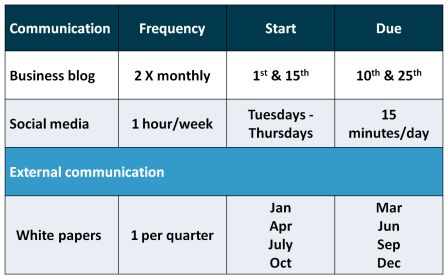Getting eliminated on Food Network’s Chopped is bad enough.
When the reason is Your time has run out –
- And the plate’s empty
- Well, that’s a real kick in your plans
In Part 8 of a 10-part series, we provide tips for creating a timeline for your business communication plan.
The Challenge
There are three rounds to the Chopped challenge – the appetizer, entree and dessert round.
- Each round is timed
- A contestant is eliminated each round
- The winner is judged on all three rounds
If time runs out on a contestant before they get their preparation on the plate, they will be chopped.
Without a business communication timeline, you could be chopped.
Here are 3 lessons from Chopped that help you in developing your timeline.
#1 – Use Your Time Wisely
The show gives contestants four ingredients they must use in their dish. Contestants also have access to a kitchen and pantry where they can select items to go with the mandatory ingredients.
Each round is only 20 to 30 minutes. They must use their time wisely.
- Some ingredients take a long time to cook
- Others require a longer preparation (prep) time
- Contestants need planning and plating time
1. A Long Cooking Time
Some business communication take a long time to see results.
- Networking is long-term strategy
- Growing a blog following takes time
- Building brand recognition happens over time
Develop a timeline that is consistent and ongoing for best results.
The contestant who pops an ingredient in the oven and forgets about it is going to end up getting burned.
- Check in often to see how things are cooking
- Make adjustments as needed
- Turn up the heat, stir things up
The perfect example is the neglected business blog. Left alone, it eventually dries out.
2. Sufficient Prep Time
Chopped loves to throw challenging ingredients at their contestants.
- Some of those ingredients are difficult to peel or open
- Before they even start to cook, contestants have considerable prep time
Factor in lead time for business communication requiring more preparation.
For example, a white paper requires more research than a 300-word blog post. That and its typical length (7 to 9 pages) means more time until you have a finished product.
3. Planning and Plating
If you have been following the steps in this series, you have a head-start on planning.
Now, you need time for planning the timeline that makes sense for your business communication.
- Look at your planned communication vehicles
- Separate them into projects – e.g., Business blog, Social media, External communication
- List any subcategories – e.g., White papers, case studies, print ads for External communication
- Indicate the frequency for each – e.g., Weekly, monthly, quarterly
- Estimate start and due dates
Let’s look at an example.
The above example is a simplified version – because I love simple.
- You can add as much detail as you like – e.g., specific tasks, assignments, etc.
- Some businesses prefer incorporating the budget for each project
There are advantages to keeping a timeline high-level and basic.
- The timeline gives you an uncluttered snapshot of what’s planned
- It helps you identify strengths, weaknesses, opportunities, threats (SWOT analysis)
A SWOT analysis is a planning method. Here are questions you could use for the above example.
- Strengths –which of the communications do you or your team do really well?
- Weaknesses – which are you weak at?
- Opportunities – which provide you with the most bang for your buck?
- Threats – which are areas where you have the most competition?
By going through the analysis you can make informed decisions about things like scheduling, outsourcing and establishing priorities.
You plate up your best business communication.
#2 – Don’t Throw in Too Many Ingredients
Sometimes the Chopped contestants try to do too much in too little time.
The results can be disastrous.
Look at your timeline with a critical eye.
- Do you have the resources to handle all you have planned?
- Is your message lost in the delivery of all that’s planned?
- Are you setting yourself up for failure?
Remember my holy mantra about strategic planning –
The best thing about plans is you can always change them.
#3 – Make it All Come Together
One of the elements the judges look for is cohesiveness to the three courses.
Imagine your business communication is your clients’ gourmet meal at their favorite restaurant.
- Each course is carefully planned
- There’s just the right portion
- They are served in a timely manner
- They complement one another in culinary delight
Put your brand – your message on each course.
Consistently delivering a delectable experience will have your customers coming back for seconds.
=====================
This is Part 8 in a 10-part series for developing a business communication plan. I would love to have your feedback. Please share those in Comments.
=====================
Prior Posts in Series
Part 1 – Does Your Vision Statement Reflect Your Dream?
Part 2 – Learn From Lieutenant Colombo to I.D. Your Killer Client
Part 3 – Why Blind Hog Business Communication Objectives Don’t Work
Part 4 – Busting 3 Budget Myths for Your Business Communication Plan
Part 5 – Are Your Business Communication Vehicles Driving You?
Part 6 – A Control Freak Guide to Business Communication Roles & Responsibilities
Part 7 – Does Your Message Stink From the Headline Down?
Follow-up Posts in Series
Part 9 – Is Your Hamster Wheel Business Communication Getting You Nowhere?
Part 10 – Do You Have Your Business Communication on Autopilot?
=====================
Helping you Keep it simple, clear & uniquely yours – contact me for help with your business writing needs.
=====================






Hi Cathy,
Excellent analogy here.
Like cooking, your business communication timeline looks best when it’s “just right”. Tweak, test, repeat the process. As you note the plan can be adjusted at any time. No need to stick to it when it just isn’t working, and of course, no need to abandon it, when it’s working just fine and you are impatient.
Awesome note too about a lost message. I was offline for quite a bit last month and realized that my message was being diluted, because I was receiving nice results working 8 to 10 less hours a day. Ouch…but lesson learned. I stay on topic/niche 95% of the time to tweet of FB share a clear, distinct consistent message, which does not confuse my audience.
Thanks for sharing your insight Cathy.
RB
Hi Ryan-Good to see you back here again. I think because we have various interests, it’s easy to stray off our message. If we tie it all in, it works, and as you say, it doesn’t confuse our audience.
Thanks for sharing your insight, Ryan.